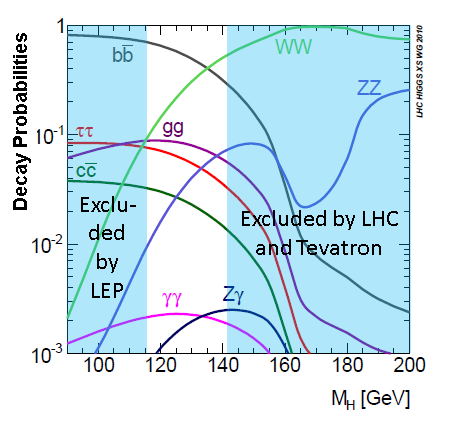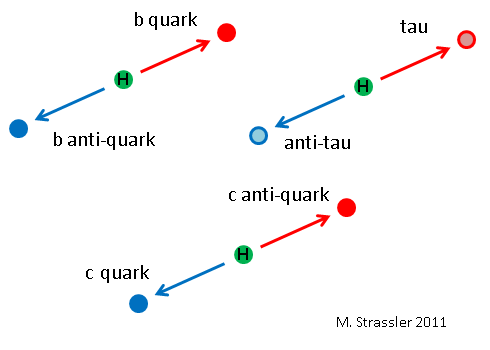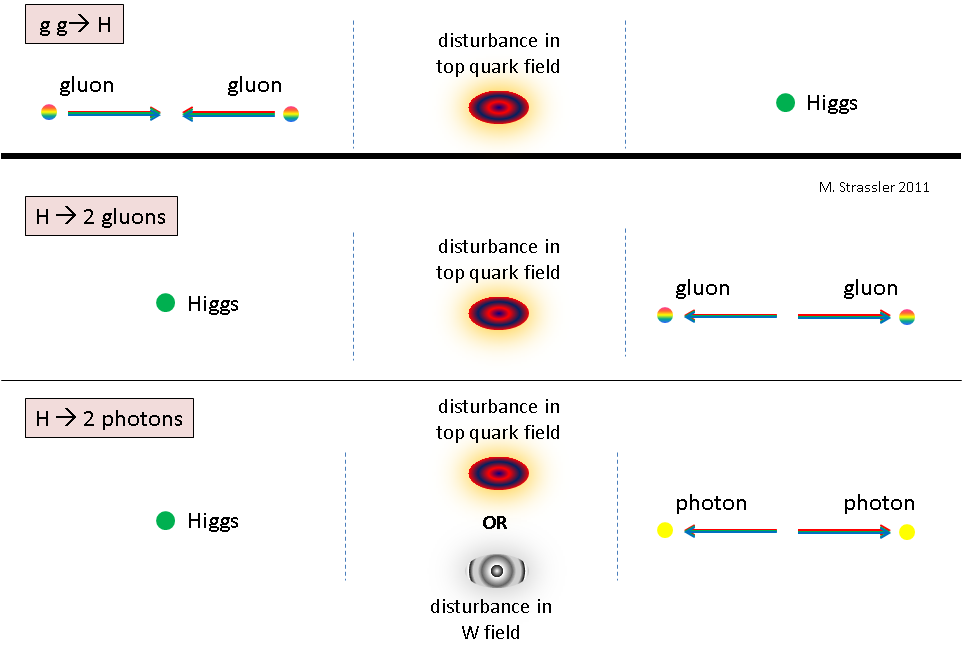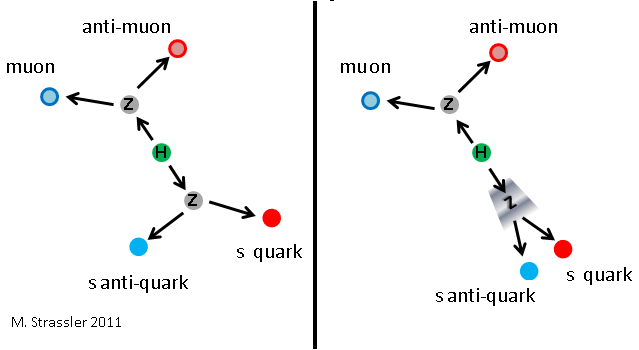Matt Strassler 12/11/11
The Standard Model Higgs (the simplest possible type of Higgs particle that might be present in nature), decays very rapidly, as do most types of particles. In a time far shorter than the time it takes for light to travel from one side of an atom to the other, a Higgs particle that is produced at the Large Hadron Collider [LHC] will decay to other particles. Which other particles, and with what probabilities? And why do we care? These are the questions that this article addresses.
The Higgs field (not the Higgs particle, which is just a ripple in the Higgs field) gives mass to all of the known apparently-elementary massive particles: all the quarks, all the charged leptons, the W and Z particle, and even the neutrinos. The only particles it leaves alone are the gluons and the photon (and the presumed graviton). This is all very well understood within the equations of the Standard Model of particle physics, which describe all of these particles and their fields. It’s clear from those equations that it is impossible for any of these particles to be massive if there isn’t some kind of Higgs field around.
Caution: don’t get the impression that everything in nature that has a mass got it from the Higgs field. The Higgs field doesn’t even give the Higgs particle its mass! More precisely, the Higgs particle’s mass gets a contribution from the Higgs field, but it gets an additional big contribution from elsewhere. And there may be many other types of particles in nature, such as the particles of dark matter, that get their masses from elsewhere too.
As a consequence of all of this, the Higgs particle interacts directly with the known particles with a strength related to their masses. (As we’ll see, it also has indirect interactions with the gluons and photon, even though they’re massless — but let’s not get ahead of ourselves.) And consequently it decays to pairs of these particles (more precisely, to a particle and its antiparticle) with a rate that is related to their masses, as long as the interaction is direct. Roughly speaking, decays to heavy particles are more likely than those to lightweight particles… though there are caveats to come.
For example, since bottom quarks are much heavier than electrons, a Higgs particle is vastly more likely to decay to a bottom quark and bottom anti-quark than to an electron and a positron. How much more likely? The ratio of the probabilities of the two decays is proportional to the bottom quark mass, divided by the electron mass, squared (and then multiplied by 3, because of the properties of the strong nuclear force), giving
3 (mbottom / melectron)2 = 200,000,000 or so
That’s a big number! We can forget about measuring Higgs particles decaying to electrons; we’d need to make at least 200,000,000 of them (actually far, far more), and we’ve probably only made 100,000 or so at this point.

Ok, so let’s look at all the decays of the Standard Model Higgs to all of the available particles. The ATLAS and CMS experiments at the Large Hadron Collider LHC have already excluded a Standard Model Higgs particle between 141 and 470 GeV in mass-energy [E=mc2], and there are reasons to believe the Standard Model Higgs should be below 400 or so from other precision measurements, so for the purposes of this article let’s focus on the lightweight case. In Figure 1 you see the probabilities for such a Higgs to decay to various particles, compiled with the latest methods by the LHC Higgs Cross Section Working Group.
Let’s even be more precise for a 125 GeV Standard Model Higgs; follow me down the graph.
- 60% of such particles would decay to bottom (b) quark/antiquark pairs
- 21% would decay to W particles (though see below!)
- 9% would decay to two gluons (g)
- 5% would decay to tau (τ) lepton/antilepton pairs
- 2.5% would decay to charm (c) quark/antiquark pairs
- 2.5% would decay to Z particles (though see below!)
- 0.2% would decay to two photons (γ)
- 0.15% would decay to a photon and a Z particle
There are three classes of decays in this plot:
First, there are decays through direct interactions to a particle and its antiparticle; see Figure 2. From largest to smallest probability, these are
- decay to a bottom quark/antiquark pair (the bottom quark has a mass of 4.5 GeV)
- decay to a tau lepton/antilepton pair (the tau lepton has a mass of 1.8 GeV)
- decay to a charm quark/antiquark pair (the charm quark has a mass of 1.3 GeV)

There are also other decays, to other quarks and leptons, that are not shown. Why not? You already know why the decay to an electron isn’t shown; why bother? it is far too small to measure. The same is true for muons and for strange, down and up quarks. They are all very lightweight, and their interaction with the Higgs field is therefore very weak, implying that the probability that the Higgs particle decays to them is very small. And why isn’t there a decay to a top quark and antiquark shown? The top quark has a mass of 173 GeV or so, so a Higgs of 140 GeV and below cannot decay to a top quark and a top antiquark. (But see below.)
Second, there are decays through indirect interactions to gluons and to photons. These occur through an effect of “virtual `particles’ ” (which are not really particles at all, but disturbances in the corresponding fields.) In particular, (see Figure 3) because
- gluons interact directly with top quarks
- photons interact directly with top quarks and W particles
- Higgs particles interact directly and rather strongly with W particles and top quarks
the Higgs gets to decay to gluons through the indirect effect of virtual top quark/antiquark pairs (i.e. through a generalized disturbance in the top quark field), and it gets to decay to photons through the indirect effect of virtual top quark/antiquark particles and virtual W particles. These indirect interactions are quite a bit smaller than the direct ones, which is why these decays are rather rare, especially the decay to photons, which happens only for about 1 in 1000 Higgs particles. There is also a decay to a photon and a Z particle which I didn’t bother to put in Figure 3, but is similar to the case with two photons.

Third — and most important, as we’ll see — there are decays which, on the graph, are marked WW and ZZ. That looks as though these refer to two W particles and two Z particles. But wait! That can’t be right! The Z particle has a mass-energy of 91 GeV. If the Higgs particle has a mass-energy of 140 GeV, how can it decay to two Z particles, which collectively have a mass-energy of 182 GeV to start with (and possibly additional motion-energy, which is always greater than zero)? It’s clear how a 200 GeV Higgs particle could decay to two Z particles, but why is it still true for a 140 GeV Higgs particle?
The solution to this puzzle is this: one has to remember the world is made from quantum fields, and fields can do more than just host particles with a definite mass. This Higgs decay is not to two Z particles, but to one Z particle that is a real particle and to one Z “virtual particle”, which is not a particle at all, but a more generalized disturbance in the Z field. (A particle is a nicely behaved ripple; a `virtual particle’ can be much more of a messy thing, in general.) Then the Z particle decays (into a charged lepton/antilepton pair, a neutrino/antineutrino pair, or a quark/antiquark pair) and the Z virtual particle falls apart too, in a similar fashion. In the end, we can get, for instance, two charged leptons and two charged antileptons, or a charged lepton/antilepton pair and a quark/antiquark pair. (The same is true for the decays marked WW, except that the final set of particles might be, for instance, a charged lepton, a charged antilepton, a neutrino and an antineutrino.) This is illustrated in Figure 4 both for the case where the Higgs is heavy enough to decay to two Z particles and when it isn’t; the same particles come out in the end, but the particles that come from the Z virtual `particle’ have somewhat smaller energies and momenta than those that come from the real Z particle. The lighter is the Higgs particle, the harder it becomes to make the virtual Z particle, and the more suppressed is the probability for the process; you can see how this affects ZZ (and WW) in Figure 1, which are much smaller for very light Higgs particles.

You might ask why a Higgs particle can’t decay to a virtual top quark particle and a top antiquark. It can! But the probability is so small it isn’t worth putting on the graph in Figure 1.
Ok, what could we learn if we measured all of the probabilities for the decays shown?
The probabilities for the decays through direct interactions answer the question: do the Standard Model matter quarks and charged leptons get their masses from the Higgs field precisely as the Standard Model’s equations would predict? If any of the decay probabilities are off, that means that certain matter particles in the Standard Model get mass in some more complicated way, and the Higgs particle is not a Standard Model Higgs particle, but something more complicated. Since it is possible that the quarks get their masses one way and the leptons get their masses in a different way, it is very interesting to measure the decay probabilities both for quarks like the bottom quark and for charged leptons like the tau. Measuring the charm quark decay is difficult, unfortunately. Someday we may have enough data to detect the decay to a muon and an anti-muon, but that is a long way off.
The decays to a W particle and a W virtual particle (WW*, for short), and for ZZ* are enormously important, because even if we measure them very imprecisely, they answer the fundamental question: is this particle we are calling a Higgs particle actually a Higgs particle in the first place?! Only a Higgs particle can be expected to have a much larger probability to decay to WW* than it does for its decay to photons or to photon plus a Z.
With more precise measurements, these decays will help answer an equally important questions: is the Higgs more complicated than a Standard Model Higgs particle? In particular, is there more than one Higgs particle in nature? If the decay probabilities for WW* and ZZ* are smaller than they should be for the Standard Model Higgs particle, then the answer to at least the first and probably both questions will be “yes!”
Finally, the decay that goes via an indirect interaction to photons might occur with a probability that disagrees with the Standard Model if (a) the indirect interactions between Higgs particles and top quarks and between Higgs particles and W particles are not of the size and nature expected in the Standard Model, or (b) there are heavy previously unknown particles that interact with both Higgs particles and photons. (The same logic applies for the decay to gluons, although this decay is unlikely to be measurable, as will be discussed in the third article of this series.)
So each of the decays give us a different and important piece of information about the Higgs particle — in particular,
- all the direct decays to quarks, charged leptons, W and Z particles tell us something about the strength with which the Higgs particle interacts with the particle to which it decays,
- which in turn tells us how strongly the Higgs field interacts with the corresponding particle,
- which should (if the Standard Model is right) be proportional to that particle’s mass.
Some of this information — in particular, how the Higgs interacts with W and Z particles and top quarks — can also obtained from the production modes of the Higgs particle. So it might look as though here is some redundancy here. But first, redundancy is good; even if you expect to get the same answer from two measurements, nature might surprise you and give you different answers, which would mean that there are some novel effects you need to understand. And second, it isn’t possible to measure all of these production modes and decay modes separately. In fact, each measurement of the Higgs’ particle’s properties involves the rate for a particular production process multiplied by the probability of a particular decay process; so to measure production rates and decay probabilities separately is actually very tricky. How to do all that (to the extent possible) is discussed in the third article of this series.


30 Responses
I think this is one of the most important info for me. And i am glad reading your article.
But should remark on few general things, The web site style is perfect, the articles is really
great : D. Good job, cheers
whe the proton is smashed the four separate anti down quarks are reconfigured in a lower energy state as two up quarks each with a charge of (+2/3 } the mass energy lost from the proton is redistributed betwwen the mass of the quarks the volocity of the quarks and the energy which escapes as photon radiation
nope. Makes no physical sense.
You say above “The Higgs field (…) gives mass to (…) even the neutrinos.” However, the neutrinos are massless in the standard model. Depending on the nature of the neutrino (Dirac or Majorana) the origin of their mass may not be directly related to the Higgs field (at least not in the same way as for the other fermions). no ?
Don’t ideas like the seesaw mechanism still require the higgs field to generate the neutrino mass?
Yes.
The best way to say it is that if there were no Higgs field, the structure of the Standard Model makes it impossible for the neutrinos to be massive for the same reason that it is impossible for the electron to be massive. In short, the Higgs field MUST participate in the neutrino masses. If the neutrinos are Dirac, then the Higgs field gives neutrinos their masses in the same way as it does the electron; it they are Majorana, it does so in a different way, but it is still the responsible party.
Hi, Prof. Strassler is there a simple explanation why the branching ratio of H to WW much bigger than H to ZZ?
Thanks.
Yes. First, it isn’t THAT much bigger. Second, the W+ is complex and the Z is real [i.e. there are two W’s, one with + charge and one with – charge, and only one Z), so there’s a factor of 2 there. Third, the Z is heavier so the Z virtual particle is more virtual than the W virtual particle is in the corresponding decay, and that suppresses the rate. [Finally, but maybe you accounted for this already, the number that you actually observe is smaller because the W has 22% chance of decaying to an electron or muon while the Z has a 6% chance of decaying to electron-positron or muon-antimuon, and that gets squared when you’re requiring the maximum number of charged leptons in your search strategies.]
So does this mean the latest tentative results for higgs->photon,photon rates puts a lower limit on any yet undiscovered heavy charged particles. i.e a charged particle somewhat heavier than the top quark would noticably contribute to an increased higgs->photon,photon rate.
It does put limits, yes, but not as simple as you state. The limits are complicated by the fact that contributions to the rate from different types of particles can be positive or negative, and also that there are effects both on the production rate of Higgs particles and on the rate for decay to two photons.
IMO Higgs field is miniaturized version of dark matter foam, which reflects the symmetry of Universe. Dense aether model models the space-time as a water surface, where the dispersion of energy is similar to both large, both small dimensional scales. The geometry of these fluctuations is self-similar: they can be modeled with system of dense packed hyperspheres, which leads into dodecahedral geometry of density fluctuations. At the case of CMBR this geometry can be observed like the peaks at the power spectrum of CMBR field. My assumption therefore is, the same feature should be observable at the power spectrum of particle collisions, attributed to Higgs field and it’s not related to any particular particle.
Thank you for your opinion.
1. “More precisely, the Higgs particle’s mass gets a contribution from the Higgs field, but it gets an additional big contribution from elsewhere.”
Don’t leave us hanging! What’s this “elsewhere”?
2. “Only a Higgs particle can be expected to have a much larger probability to decay to WW* than it does for its decay to photons or to photon plus a Z.”
Why exactly?
1. I’m going to have to leave you hanging. Depending on the theory you prefer for the Higgs particle (is it elementary or composite? is there supersymmetry? are there several Higgs particles? are there extra dimensions) the answer is different. So we will have to wait for LHC’s data and hope that it teaches us the answer.
2. That is because the Higgs decay to WW and ZZ is controlled by the same interaction that gives the W and Z their masses — it is a direct interaction. The decay to photons occurs through the indirect effect of virtual particles and is much smaller. This is odd at first glance (and second glance) because the photon and Z are mixtures of two (formerly massless) particles, the W3 and the X [see my article http://profmattstrassler.com/articles-and-posts/particle-physics-basics/the-known-particles-if-the-higgs-field-were-zero/ ]
A non-Higgs particle would either (a) have an indirect interaction with W and Z particles, and decay to them rarely, or (b) have a direct interaction with photons of a similar strength to W and Z particles, and decay to them all with similar rates. Examples of both (a) and (b) can easily be written down in theories.
It is the very special and unique feature of a Higgs particle that it will have very different interactions with the force-carrier particles (W,Z) to which it gave mass from those to which it did not (photons, gluons).
“True — until you look really carefully. Actually it’s even more subtle than that 😉 and someday I’ll write the article explaining that remark, so keep an eye out.”
I ‘d like to add my vote for that article !
means when our matter tells the space how to bend, its not the Higgs?
The Higgs has nothing whatsoever to do with gravity. Gravity interacts with momentum and energy (and with mass, of course, but just because mass has associated mass-energy E=m c2.) For instance, the gravity from the sun bends light, because photons (particles of light) carry energy, even though photons have no mass. The Higgs field provides mass to some particles, yes; but other particles (including the Higgs) get part or all of their masses from other sources. So no, do not confuse the two.
While Higgs field, if confirmed gives mass to some particles – W, Z, quarks, and charged leptons, most of the mass in our universe comes from binding energy..
True — until you look really carefully. Actually it’s even more subtle than that 😉 and someday I’ll write the article explaining that remark, so keep an eye out.